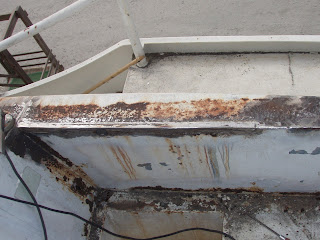We have come to realize that on a project this big, it is certainly a Family Affair. We are all learning how we can serve the project best, and when it is our time to jump in. We recently replaced 8 of the stanchions (the posts that hold the lifelines) around the deck. You will see here, that we each had a role to play in the success of a job well done. Please note, that once again, Valin seems to have taken most of the pictures of this project. Also, because I have been working along side of them, I do not have the opportunity to take as many pictures. Although not 'shown', Valin was our all around go-getter and expert fire watch guy, always standing by with a bottle of water and a positive attitude!

Blayde performed the initial step; using the grinder fitted with a cutting disk, to cut the upper and lower part of the bad piece.

Drake came along when needed, and pounded the piece out with a sledgehammer.

I used the 7" grinder to smooth out both sides of the remaining material, to aid in the custom fit of the replacement piece.

Tamer then fitted and welded in the new clean, non corroded, un-rusty piece of steel pipe. Not pictured, is the final step, which is to come at it again with the grinder and smooth out all the welds and heat mess. Ready for painting!!
SANDBLASTING

Tamer in the anchor locker, running a test with the sandblaster to make sure that it works well, and that the suit provides adequate ventilation. I needed to take over so that he could finish welding all the new stanchions into place.

My Turn!!!
This picture proves that looks truly can be deceiving :-) Here I am suited up and ready to sandblast the anchor locker. I ended up in there for a total of about 4 hours, which at the end of, I was completly disgusted with sand! Because I suffer from claustrophobia, this was an exceptionally difficult task for me mentally. First, you have a face shield covering the whole front of your face, you cover that with a hood that has a small viewing lens, then you have to put on the hat to keep it all in place. Next is getting down into the tarped in anchor locker, and at times sandblasting steel 6 inches in front of your face... All the while not being able to really see what you are doing...

Thumbs up..... Little do I know what awaits me.....

Valin standing safety watch while I sandblasted.

Drake and Blayde "Standing by".


















